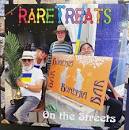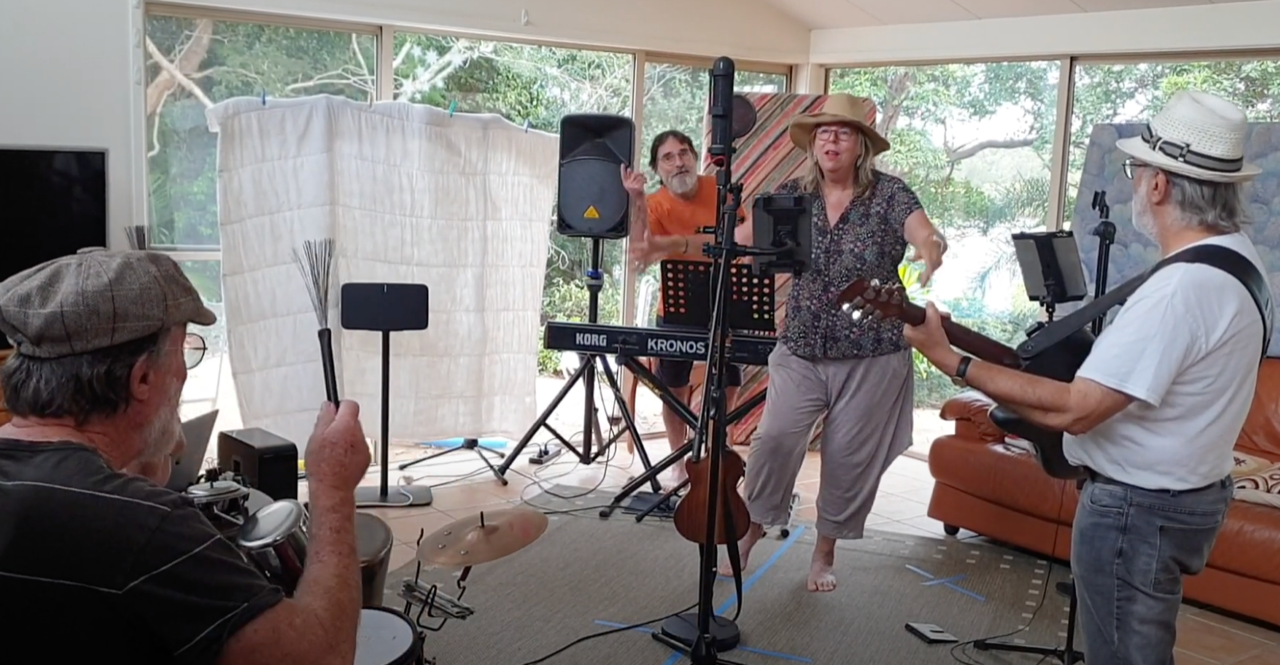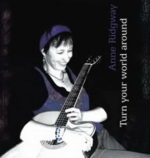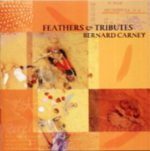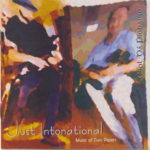Description
RareTreats – On the Streets
CD review by Chris Spencer
TN2506-89 $20
TN160 Dec 23
RareTreats, and it seems there is no space between the “e” & the ’t”, are like a four piece jug band without the jug!
Most of the instruments are acoustic, except for the keyboard, which adds some nice touches to several songs.
Nevertheless, the keyboard was quite unexpected.
So you have the ukulele, mandolin, kazoo, guitar and percussion.
They play a variety of styles, so it’s difficult to pigeonhole them.
There’s reggae (“Little Town”), skiffle (“Dial 63789”, “Try it Again”), latin (“Fancy Little Dancer”), a love ballad (“I Think This is Love”) and Soul (“Let the Skin begin”).
The most jugband-like song is the band’s signature song: “RareTreats are back in Town”, driven by the ukulele of Trudy Van Laar.
The only song not credited to the band is “Old Brown River”, ironically credited to Jeff Browne, and as far as I can tell it’s not about the Yarra River.
Most of the songs are credited to Terry Carlan who plays mandolin and sings.
Another reviewer has suggested that the band have borrowed tunes from elsewhere, set to their own lyrics.
I can’t corroborate his theory, but the tunes certainly have that familiarity of having been heard before.
This may well be the ability of the songwriters to write competent songs in the styles mentioned above.
There’s the social commentary of “Refugee Blues”; humour in “Dial 63789” which comments on the frustrations of being in a queue when making phone calls.
Other members of the band not previously mentioned are Cec Bucello, who has written some of the songs, on guitar, vocals and percussion, and keyboardist, Greg Frohlich.
Another point of interest is that the album was recorded live, using just one microphone, rather than utilising overdubs, expertly engineered by Tony Macfarlane, at Hear After Studios.
There’s a whole article on the recording process on the Trad & Now website: https://tradandnow.com/product/raretreats/
On the basis of listening to this album several times, RareTreats are a band I would like to see live.
Their varied repertoire with multi-instrumentalists makes for an entertaining performance.
Single mic single take – recording RareTreats “On The Streets”
by Tony Macfarlane, Engineer, The Hear After
Published in T&N151 October 2022
The RareTreats were hot, having just done well in original song writing competitions.
They were highly practised, with all their act together from their recent stint as invited buskers at the National Folk Festival.
They were in a good musical place all round.
To capture the sound of the Treats for their new album, “On the Streets”, we decided to try recording them live, using single takes only, with a single microphone.
The secret sauce for this style of recording is a band that knows their stuff, is well rehearsed, and plays easily together.
Using a live take preserves the energy and musicality of the band in a way that multi-tracking may not.
The musical communication between players, looking at each other and bouncing off each other in real time, and the immediacy of the music, shines out when the musicians are playing together, at least we found it so.
I say “single microphone”, but another secret to capturing these live performances was in the particular microphone used.
It was actually two mics in one, an AEA R88a stereo ribbon mic.
This is a very special mic.
Its use is championed by American recording engineer, John Cuniberti, and if you are at all interested in this technique I highly recommend looking him up on Youtube using the search words “Cuniberti Onemic”.
The music he engineers is itself a real pleasure to listen to, and his recording technique is fascinating.
Without going overboard on the technical detail, the R88a has two ribbon mics mounted at 45 degrees to one another, with one above the other in a coincident pair to give a pinpoint stereo image.
Each ribbon records both what is in front of it, and what is behind it, equally well in either direction.
So the players have plenty of space both in front of and behind the mic to set themselves up.
The sound must come from a 90 degree sector, either in front of the mic or behind it.
Any sounds coming from the side sectors are subject to phase cancellation.
This is best illustrated in the diagram which shows the setup of a band for one of Cuniberti’s recording sessions using the R88.
In this case, the bass player and the electric guitar player were physically located in the side quarters, but their amps and hence the sound, were in the front/rear quarters.
When using this style of recording, the volume balance between the band members is achieved either by them singing or playing louder or softer, or by adjusting how close they were to the mic, or by turning their amp up or down.
No faders were used in the making of this album!
The stereo image is created by where they are placed in the sector.
The lead singer is placed on the centreline, as are the bass and drums.
Accompanying instruments are placed to the left or right depending on the stereo image desired.
The two raw stereo tracks from the mic were fed into a Macbook Pro using an Apogee Duet.
That’s it….very simple.
It either worked or it didn’t.
The two stereo tracks were then each panned hard left/right and the stereo image appeared, that was pretty well most of the post processing.
No mixing required, in fact no mixing possible.
There were some additional tweaks using outboard, mid/side compression and mid/side EQ, but to be honest, the improvements were subtle and the tracks could have stood without that.
So, all sounds easy eh?
Well, the hard part was figuring out where everyone should stand and how loud they should sing/play.
Neither I nor the Treats had ever done anything like this before.
The R88a arrived at my place in Sawtell in the week before the Treats did so I was able to have a bit of a play-around to see how it might all work, but the real trials started once the band rocked up to The Hear After.
We had just under 4 days to lay down the album.
The mic was positioned roughly in the middle of the space.
The centreline of the mic, together with its “sector limits”, were marked on the floor using masking tape.
Fortunately we had a large room to work with and we used a lot of that space.
With no experience to call on, we had a stab at what should be done, tried one take and then listened.
Not too foul, but a long way short of the mark.
The volume on the keyboard amp was adjusted, the drums (Terry’s delightful little suitcase set) were moved back a bit, the singers and instrument tutored in volume, everyone shifted a bit to adjust the stereo image.
Second take, better.
Play-listen-adjust.
Everyone listened on a 4 channel headphone amp.
I guess it probably took us about half a dozen goes to get that first song right.
Masking tape was the crucial tool in getting the musos into the right position in a repeatable way.
Subsequent songs came easier, but each song had its own challenges.
You see, with a band like the RareTreats, everyone does more than one thing and the band was put together differently for each song.
Cec plays banjo, guitar and mando, sings lead and backup vocals, and covers on drums for Terry when he is at the mic.
Trudy sings lead and backup vocals, does percussion, and plays the uke.
Greg is the keyboard player but also sings lead vocals and backup, and Terry sings lead and backup, plus plays guitar, mandolin and drums.
So for each song we had to find out how to arrange people physically in the room.
It was a bit of work for the first few songs but we got better at it as time passed.
Another sort of challenge was when one member of the band played an acoustic instrument but also sang lead.
To get the lead vocal at the right volume they had to stand pretty close to the mike but then the instrument could then be too loud – Catch 22.
Sometimes they just had to play more softly, which threw them a bit, or we could lift the mic so that their instrument was further away than their voice, and sometimes they just put their instrument away.
We were able to get this sorted most times.
One final aspect of the recording is that the R88 is a “far field” mic.
It is not one of those mics that you have to swallow to sing into, or place right in front of a speaker cabinet.
It excels at picking up sounds from all around the room.
The drums were a good 5m from the mic, as was the keyboard amp.
For one song, Cec was sitting on a sofa at the back of the room, well below mic level, gently plucking a mandolin, but he came through bell-like and clear.
The closest any vocalist got to the mic was about a foot.
We laid down 14 tracks.
11 made it onto the album, all original.
One of the other three tracks was a cover of Red Right Hand by Nick Cave, very good but no place for it on an album of originals.
The other two tracks that didn’t make it onto the album blew me away.
We got up on Tuesday morning, the day they were leaving, and Cec and Terry each rushed out saying they had written a song overnight.
We managed to arrange them, set up, record them and have them in the can before they left to go back to the Central Coast at high noon.
Bloody good songs too!
Maybe we could have done better on a couple of the tracks, technically that is.
Perhaps on a future RareTreats album we will, but the learning curve was steep and I think we did well.
Each song is original, was recorded with a single mic, in only a single take, with no further mixing or balancing possible, and very minimal post processing.
We were all chuffed with the outcome.
14 tracks in just under 4 days, having all the energy that shines from the RareTreats!
Breaking News!
After only two weeks on the international music platform N1M, the first track on the RareTreats album, 63789, debuted at number 5 on the Folk music in Australia Chart and shot to number one in the second week.
Move over Ed Sheeran!
Infinite Song Competition uncovers Ukraine protest song
Published in T&N148 May 2022
The National Folk festival, held in Canberra over the Easter break, has for the past 19 festivals included an Infinite Song Competition.
It all started many years ago with performers invited to play their version of Led Zeppelin’s Stairway to Heaven and has developed from there to become one of the most popular events at the festival.
Over the years the artists selected to be covered have changed from one song to anything done by that artist, with the most memorable for me being Leonard Cohen and the Bee Gees.
Venues for heats and finals over flowed and it is always good to see well known acts performing material well out of their normal comfort zones.
In 2022, the artist selected was surprisingly, Dolly Parton, someone who is well known around the world, reported to have written 3,000 songs, but not too many of those being folk songs.
Nevertheless, many well-known and new performers took up the challenge with some doing straight covers while others wrote parodies, most of which were political.
Pauline, Pauline instead of Joelene, Joelene, was one that two very different artists thought up separately.
Bruce Watson was one of those artists and his clever lyrics and being dressed up as Dolly, fish net stockings and all, won him third place in the final.
However, the subject matter of this article is how Dolly’s well-known 9 to 5 became a Russian invasion protest song.
The original starts with an alarm clock ringing and Dolly singing about getting out of bed, having a shower, getting dressed and going off to work, facing many issues along the way – traffic, office politics, being tired etc.
We can all relate to that.
But imagine if instead of waking up in the USA or Australia, you wake up in Mariupol, or Kyiv, or Odessa, or one of the many towns and villages in the Ukraine.
Your issues are much more serious there with the lack of food, electricity, safety, water, a roof over your head, no income, not knowing what’s happening next, all being extremely stressful.
NSW Central Coast four-piece band, RareTreats, put the two together to come up with ‘9 to 5, Someone has to stop him’.
Their performance took them from the first heat straight to the final in the festival’s main venue, the Budawang stage, where it was extremely well received by the large audience and judges and came in second.
Here’s a YouTube link to the performance as recorded by Merrilyn Vale on her mobile phone.
Here are the lyrics and chords and it would be good if people around Australia pick it up and play it to spread the message contained within.
As was published in Trad&Now 147, “Australian musicians stand with Ukraine”.
From 9 to 5, someone has to stop him
by Cec’ll B de Mann with a little help from Trudy (apologies to Dolly P)
(D) Tumble out of bed, I’m worried about Poo tin,
(G) He’s got far too much ambition
(D) I yawn and stretch while he takes another (A) life (or three)
(D) Jump in the shower and the blood starts a pumpin’,
(G) While out on the streets the tanks start rumblin’
(D) And the bombs keep a comin’ (A) daily from 9 to (D) 5
Chorus
(G) From 9 to 5, the Russians keep on coming,
It’s (D) Poo tin’s war and he won’t stop the bombing;
He’ had (G) lots of tanks, roaming and a roving;
It’s (Em) Poo tin’s war, doesn’t (A7) care where bombs are falling
From (G) 9 to 5, someone has to stop him,
it’s (D) Poo tin’s war and his motions are ongoing;
He’s got (G) missiles and bombs that we’re all a dreading;
Perhaps a (Em) no-fly zone is (A7) where we’re all a heading
Verse 2
(D) Bangs and booms have got me hoppin’,
(G) Dawn ‘till midnight there’s no stoppin’
(D) Never knowin’ which house he’s going to (A) smite
(D) Children crying, civilians dying, (G) But a war criminal he’s denying
(D) Where’s Tony Abbott (A) to shirt front him (D) tonight?
Chorus
Verse 3
(D) He’s read a book about Russian history,
His (G) expansion plans are a world wide mystery
(D) He’s looking to de nazify U (A) kraine
(D) But that’s absurd, a total fabrication,
(G) he just wants a bigger nation
(D) Maybe next (A) he’s goin’ after (D) Spain
Chorus
Verse 4
(D) Dreams and plans are in the making,
(G) Success is out there for the taking
(D) That’s what Dolly said in her fourth (A) verse
(D) But those Ukranians, they’re not fading,
(G) they’re standing up to this invasion
(D) I wonder if (A) us Ozzies would do (D) worse
Chorus
Repeat chorus
